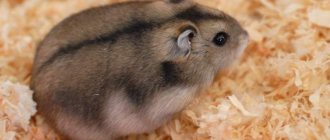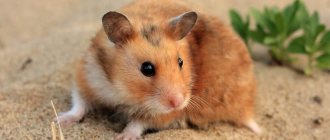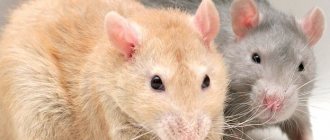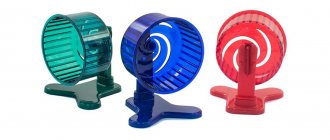- home
- Acquisition
16.07.2018
When purchasing a rodent, you need to take into account many factors, the main ones being the sex, breed and age of the animal. But it is also important to know where you can buy a hamster so that it is healthy and energetic and makes the whole family happy. Caring parents are also concerned about the question of which hamster is best to buy for their child.
Male or female
If you are planning to have one hamster, then there is not much difference between a male and a female. And yet there are certain differences between them. Males are larger, more flexible and kind. But do not rush to make a choice in favor of boys, they give off a stronger and more unpleasant smell. You will have to clean the place where the animal is kept very often, as it will mark its territory.
Females are cheerful and perky. But be prepared for the fact that you can bring a female from the store expecting offspring. In female hamsters, a disease of the reproductive organs, endometritis, is widespread.
When the animals are one month old, it is possible to determine whether they are a boy or a girl based on their emerging sexual characteristics.
Cell selection
A cage with vertical or horizontal bars is the most suitable and comfortable home for a hamster. Its size depends on the breed of hamster. For dwarf hamsters - Djungarian and Roborovsky - the height and width are approximately 30 cm, length - 50 cm. For golden or Syrian hamsters, it is better to choose a larger cage - 40 cm wide and high, about 60 cm long.
Unlike Syrian hamsters, Djungarian and Roborovian hamsters are indifferent to climbing rods and other acrobatic tricks, so plastic cages (dunes) are quite suitable for them. Under no circumstances should hamsters be placed in tall and narrow aquariums - bacteria multiply very quickly here, there is high humidity and there is almost no access to fresh air.
flickr/pyza
Breed
When choosing a rodent breed, pay attention to its character and behavior. There are many varieties, but two breeds are optimal for home keeping - Syrian and Dzungarian. Everyone decides for themselves who is better to have.
The Syrian hamster is the best option for a child. Quite a large specimen, characterized by good vitality, cleanliness, and the presence of different colors. Their body length is 12–18 centimeters. There are short-haired and long-haired. The following color variations are common: black, cream, brown, reddish, gray, smoky and others. In addition, babies may be spotted or striped. They are kind, affectionate and responsive. When buying a Syrian, immediately take care of a spacious cage.
The Djungarian hamster is a dwarf version of this rodent. Its length including tail is no more than 10 centimeters. Djungarians are nimble and restless, which is fraught with injury and the possibility of loss. This is aggravated by the increased timidity of the animal. But representatives of this breed can still be tamed. They are not capricious when it comes to food and are quite independent. They have different color options - gray-brown, gray with a blue tint, reddish and even white! Be careful: Djungarian hamsters are highly fertile. Another very sad fact is the short life expectancy of representatives of this breed (about 3 years).
If you decide to get a dwarf, it is important not to confuse it and not buy a Campbell hamster instead. The fact is that these two varieties are very similar in appearance, but the second is more aggressive and capricious in content.
When buying a dwarf hamster, make sure that the distance between the bars in the cage is not too large.
Which hamster is better to get: characteristics of popular species
Today, many breeds of the rodents in question are known, but not all of them can be kept at home and allowed near children. Despite their small size, hamsters can be quite aggressive. In addition, they can in some cases cause allergies. Therefore, before buying a hamster, it is advisable to borrow an animal from friends for a few days and check the reaction of the family members.
The most popular rodents that can be kept at home include the following breeds:
- Djungarian is a common species. They have gray fur with a dark stripe on the spine and are classified as dwarf because they do not grow more than ten centimeters. Compared to other breeds, they are best tamed, but due to their small size, it is better not to have them in homes with children of kindergarten age - the nimble animal can slip out of children’s hands and get injured. Suitable for children from 10 years old.
- The Campbell breed looks practical in appearance, like the Djungarian, but their character is quite capricious and they bite. Individuals have a more yellow color and a paler stripe on the back.
- Roborovsky's hamsters are one of the smallest and rarest representatives (adult animals are no larger than 6 cm). A characteristic difference is socialization; they get along with same-sex relatives in the same cage. Kids will have fun watching a bunch of rodents, but they are unlikely to be able to pick them up - they are shy.
- Among Syrian hamsters, the royal hamster is the largest representative of the breed. Adults can be compared in size to a guinea pig. A distinctive feature is that they respond to the sound of their nickname. They are quite hardy in terms of physical health and life expectancy is 3–4 years. If you want to get a rodent for your home, then choose them, but remember - if handled roughly, they will show retaliatory aggression. The coat has different lengths - Angora with long hair and short-haired. Color - from golden to black. The only inconvenience is that they need a large cage. A 7-9 year old child can handle this animal on his own.
- The grasshopper (scorpion) hamster is a wild predator that eats even lizards or scorpions, and is solitary by nature. Therefore, zoologists do not recommend purchasing it for children.
- Siberian (White Russian Dwarf). It differs in that it changes the color of its coat depending on the time of year. It grows up to 10 centimeters and gets along well with people and is friendly.
- Eversmann's hamster is a wild field animal reaching a length of 16 centimeters. It is extremely rare in captivity and is asocial, so it should not be given to children.
Red-eyed albinos are found in every breed. You should not be afraid of them - the unusual color is explained by genetic changes. Such animals are healthy and no different from other “colored” relatives.
Where can I buy
There are a lot of places where hamsters are sold, but not everywhere you will get guarantees that the pet will be alert, healthy and cheerful when it arrives at its new home. The risk of buying a sick animal is most likely in all kinds of markets. The conditions of their detention there are unbearable, in addition, there is a great danger of catching a cold or becoming infected with infectious diseases. No one can give guarantees regarding the accuracy of the date of birth, purebred or gender of the hamsters. But the market has one significant advantage - a wide range of both animals themselves and accessories for keeping and caring for them.
When buying a hamster at a pet store, you can be sure that it was kept in normal conditions and fed with high-quality food. Therefore, there are more guarantees that the animal is healthy. In addition, upon request, they will provide certificates and other documents for the animal, that is, age, breed and other data will be confirmed. The disadvantages of a pet store are the high price of a rodent and a small selection.
Another place where you can buy a hamster is a nursery. Really healthy and purebred animals are sold here. Before you go for a small rodent, read the information about the nursery and its range on the website. The nursery will not only help you make the right choice, but will also advise you on feeding and care issues. Another argument in favor of the nursery is that the animals are no longer afraid of people, they are sociable and affectionate. Therefore, the hamster and children will quickly become friends.
Care and maintenance
Caring for your pet will not take much time. Once every three days it is necessary to change the bedding and remove supplies from the hamster’s house. Feeding is simple: in the morning, just pour grains into the feeder and add clean water.
The list of priority purchases includes:
- Cage with a house. The rodent's place of residence should be equipped with slides and ledges for climbing. Experienced owners recommend choosing plastic structures that are easy to wash.
- Hard food. The rodent eats very little. It is better to buy ready-made grain mixtures marked “for hamsters”.
- Treats. Pets are always ready to eat juicy carrots, apples or cucumbers. They willingly gobble up food from the host's table (boiled buckwheat, egg or chicken fillet).
- Litter. It is more convenient for hamsters to run among sawdust than to climb over heavy pellets. The bedding is poured into a thick layer at the bottom of the cage, because pets love to bury themselves in them and sleep like that.
- Game elements (mazes, running wheel, stairs).
- Mineral stone for grinding teeth.
Important! You cannot feed your hamster fatty meat and milk, mushrooms, exotic fruits, spices, and cabbage. Apricot kernels can be fatal to your pet.
How to choose a healthy individual
When buying a hamster, learn to determine for yourself whether it is healthy. This is especially important when buying an animal for a child. Be sure to consider the conditions in which the hamster was kept, what he was fed, and check the room for dirt and drafts. Girls and boys must live in separate cages: pregnancy at an early age can harm the health of the female. The health of a hamster can be determined by its appearance, the condition of its coat, and the sparkle in its eyes. The hamster must be well-fed and radiate health with all its appearance. Discharge from the nose and eyes, unevenness on the body, and the presence of parasites are unacceptable. Detection of diarrhea and increased salivation indicate serious problems with the digestive system. In the evening and at night, the animal should be nimble and active, run, make noise, rustle. If he is lazy, slow and indifferent to everything, this is a bad sign. In your hands he should not be nervous, anxious and biting, otherwise it will be impossible to keep him at home. The presence of scratches on the body can also reveal the aggressive nature of the animal.
Cage interior
To make your pet feel happy and healthy, he needs to not only be fed, but also entertained. Golden hamsters cannot do without climbing devices - various decorative branches, tubes, labyrinths, obstacles that create several tiers in the cage at once. Here, it is necessary to have a wheel with cross bars; it can be attached to the wall or installed on the floor of the cage.
Medium-sized sawdust, compressed or mixed with shavings, as well as fine sifted sand for dwarf rocks are most often used as bedding. All types of textile or paper bedding, including newspapers, cotton wool, and rags, are strictly excluded.
An important place in a hamster’s home is a house for sleeping and resting; here he can store valuable things. The house should be quite spacious and comfortable, preferably attached to the wall. Its design should provide easy access for washing and ventilation.
flickr/pyza
Having bought a cage and placed a hamster in it, immediately install a toilet in it with a special filler that absorbs odor and moisture. You need to train your hamster to use the litter tray from an early age, otherwise retraining it will be very difficult and often impossible. The filler must be replaced once a week.
You can purchase a feeder in a store or make it yourself, taking into account the size of your pet. On average, the size of the feeder varies from three to ten centimeters, with a height of about one and a half centimeters.
You can use a small container - about 50 milliliters - as a drinking bowl. This volume will fully satisfy the hamster’s daily need for water. The water in the drinking bowl should be changed daily, and it is also very important to ensure that there is no wet sawdust around the container.
flickr/pyza
Getting used to the new home
In order for your new guest to quickly get used to his new conditions, give him a few days to leisurely explore his home. Once the initial stress has passed, innate curiosity will take over and the hamster will begin to explore its cage with interest, feeling increasingly confident.
If there is a need to take the animal, for example, to the veterinarian, it is not at all necessary to take the entire cage with you - it is enough to purchase a small carrier for rodents. Subsequently, it will come in handy during general cleaning of the cage. Alternatively, a well-ventilated cardboard box can be used.
flickr/pyza
Economic importance
Hamsters, like most rodents, harm grains, vegetables, and feed crops.
They trample and eat most of the plants around their burrow.
Wild species are carriers of pathogens: tularemia and tick-borne fever.
Pets can infect humans with skin fungus, and in rare cases, tuberculosis.
In southern countries, hamster skins are harvested.
Housing problem
The first thing that needs to be prepared for a new settler is his home. A hamster's home should be free, spacious, clean and cheerful. Your pet needs a lot of space to play and run around, as well as a lot of exercise equipment, such as wheels and toys for self-entertainment.
For the convenience of the animal, the cage floor should be covered with sawdust and soft straw, so that the little tomboy can feel at ease and comfortable, because they love to pick at something.
During the day, babies prefer to rest from a busy night, which is why their cage should have space for a sleeping place. Most likely it will be some kind of box, or a whole house, since their range in pet stores is quite wide, into which light will not pass.
Hamsters are heat-loving creatures. They inherited this from their wild relatives, whose habitat is the hot, dry desert. Therefore, when looking for a place to install the cage, bet on a warm, secluded corner near the radiator and away from drafts.
However, it is not recommended to place small rodents in your or your child’s bedroom, since these babies tend to be active at night, which will disturb your sweet sleep.











